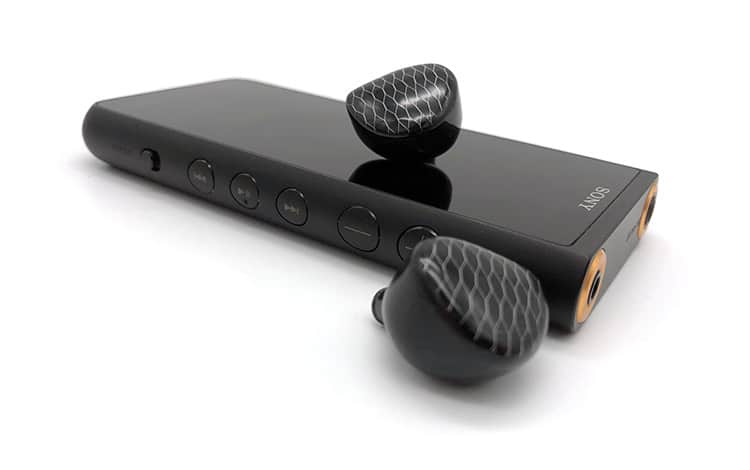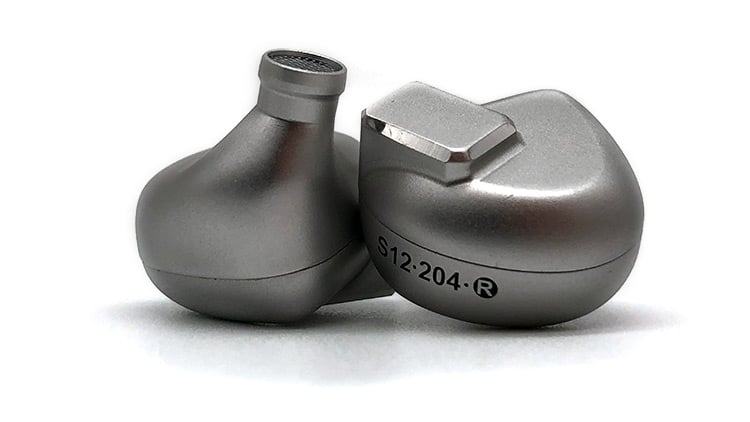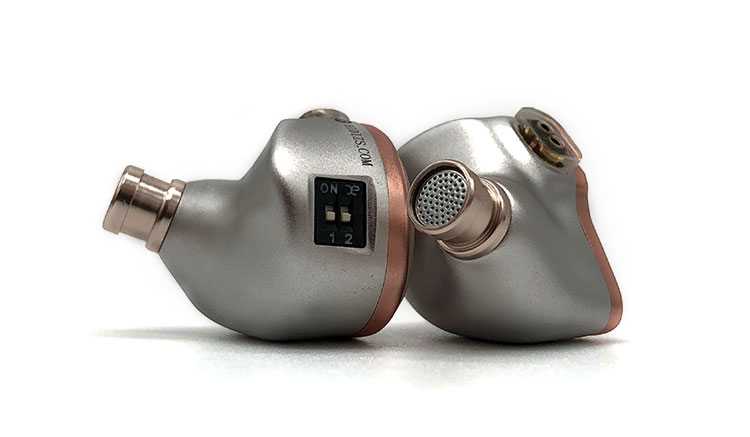Synergy
Efficiency
Even with its fairly low 16Ω resistance rating, the P1 Max has a thirst for ample amounts of juice having a sensitivity level of just 98dB. Against all the planar IEMs I’ve tested recently, and even with some dynamic ones, only the P1 Max asked the Topping DX5 to go up until the -45dB volume setting.
Portability-wise, it isn’t difficult to maximize the planar magnetic drivers of the P1 Max as I had a great time playing with it using the Sony NW-ZX507 DAP. Using a little more power than our recently reviewed Shuoer S12, the comfortable listening level is around 51% volume.
Pairings
Even with the analytical sound of the DX5, the P1 Max didn’t sound sterile. The juice it provides gave the planar drivers the push it needs to open up for a roomy and tight bass profile.
On behalf of added girth and lushness, the NW-ZX507 toned down the precision established on the DX5 altering the bass to be more present but less impactful. The sub-bass goes just as deep but lingers longer giving bass guitars extra warmth.
The vocals on the NW-ZX507 aside from playing more intimately than the DX5 are also better for longer listening having a smoother and not as shouty timbre. The treble also relaxed a bit and exchanged its steely nature for a gentler ring.
Select Comparisons
LetShuoer S12
$169
Technical
While the P1 Max isn’t a first in TinHifi’s long list of planar monitors, it isn’t until the release of the S12 that LetShuoer had a planar driver in its repertoire.
But even if the P1 Max has a lengthier history, the planar technology landscape of today made it easy for LetShuoer to catch up fast with their bigger 14.8mm planar diaphragm. The P1 Max extends lower in the frequency range going as deep as 10 Hz where the S12 measures at a reasonable 20 Hz then go up to 20 kHz.
Design
Ironically, it is the S12 that is clad in CNC-milled aluminum alloy while the shell of the P1 Max is made in a lightweight resin material shutoff by a stainless-steel torch wire drawing process around the faceplate.
The P1 Max is visually chunkier than the S12 which is thinner width-wise and more contoured in the cover making it appear smaller and compact. LetShuoer achieves the tinier case even with its bigger driver by pushing the IEM sockets outwards aiding in ergonomics as well.
Both are relatively easy on the eyes having very little complexity in their designs. But being priced the same, the shinier radiance of the P1 Max will attract more attention than the easy-to-scratch mirror finish on the S12.
Performance
With plenty of oomph for bass lovers, the S12 has a bigger and bolder appeal emerging from its broader and looser tendency. And while it doesn’t have the same airy low-end of the P1 Max, there is a gripping sensation to the S12 when it lifts longer sustains maintaining a collected and clean image only losing some crunch on bass guitars.
The midrange of the S12 places singers closer while giving a more relaxed nature to instruments such as piano and guitars. But even though the S12 has the bigger drivers, it is the P1 Max that has an easier time retrieving microdetails for that extra depth and shimmer in vibrato allowing cellos to immerse rather than attack.
Cymbals hit harder and less refined on the S12 whereas brass instruments are bigger in scale if not a bit brighter as well. The S12 while generally more intimate on stage has a more even sense of placement since the P1 Max can sound too far leaning on some songs.
Raptgo Hook-X
$239
Technical
Raptgo has a fairly young portfolio when it comes to IEMs but this doesn’t stop them from releasing a highly technical hybrid driver assembly tuned to an open-back acoustic design. If that was a mouthful, it’s because it is compared to the more typical single driver implementation on the P1 Max.
The additional driver on the Hook-X is a custom 18-layer double-sided PZT module alongside a similarly sized planar driver to the P1 Max delivering 20 Hz up to 40 kHz. Putting these two drivers together in a single IEM hasn’t been done before which gives an edge to Raptgo in the originality department.
Design
Like the P1 Max, the Hook-X is offered in a single standard color. Its shell is made of steel carved using a 5-axis CNC machine while the P1 Max is using resin for its lightweight properties.
Embracing its forward approach in designing the case of the Hook-X, Raptgo went for an eye-catching spearmint flicker around the chamfered edge of the face. This, plus the punched plane on the earpiece, gives the Hook-X a more striking profile than the subtler thin lines present on the P1 Max.
Performance
On paper, the Hook-X may have the lesser bass extension but listening to the same songs I used with the P1 Max showed its better immersive qualities and deeper extension. The P1 Max carries a neater and more immediate punch but the Hook-X is similarly chasing tightness while having a gentle roundness and added boost in energy.
Both have a similar amount of reverb in the pressing of the piano but the tuning is quite different. The P1 Max has a more aggressive tone and presence while it remains composed and less forward on the Hook-X.
A more etched detail retrieval can be heard with singing voices on the Hook-X which is in contrast to the smoother flow formed on the P1 max. And thinner sounding than the P1 Max, it returns a springier ring to edges even though it has less shimmer on brighter notes of guitars.
Continuing the thinner profile in the treble region, violins are zingier and gripping but notably less energetic. Cymbals and electric guitars can sound flat in comparison to the bold and steely tone generated by the P1 Max ending with a brittleness at times.
Staging width on the two is pretty similar but the open nature of the Hook-X bears its merits by bringing forth a more natural dispersion and placement in a live audience dynamic. Clicks, pops, and strums are placed pretty evenly but the P1 Max displaying smaller instrument images adds to the illusion of depth.
Hidizs MD4
$189
Technical
At around the same price, the MD4 can be had for its different take on music enjoyment offering not just one but four tuning styles. It achieves this through user-accessible dip-switches directly connected to the four balanced armatures installed inside.
Unlike the singular planar driver in the P1 Max encompassing the full frequency range, the MD4 is using one BA each for treble and mids while the rest is reserved for bass thickness. This assigned implementation of the MD4 extends its frequency range from 20 Hz to 40 kHz.
Design
The MD4 is the way to go if being chic is a requirement. While both take a shot at being attractive, the difference is in the added complexity of the contrasting gold in amber-like celluloid on the MD4 against the neater P1 Max.
Having an aluminum body, the MD4 does get cold to the touch unlike the resin used in the P1 Max. The contours mimicking the shape of the ear are also more visible in the MD4 but its nozzle depth can get in the way of comfort.
Performance
Unlike the more complementing balance of warmth and timbre over the different sound regions on the P1 Max, the MD4 leans closer to its objective of reaching for a thick and fun bass profile.
Around the lower region, where the P1 Max rolls off nicely after building a solid mid-bass punch, the MD4 stresses the initial attack more dispersing down with a muscular profile that quickly loses air. With deeper plucks of bass notes, the MD4 will get thicker but not as textured and dynamic as the P1 Max.
The MD4 extends its warmer profile in the midrange region where a more intimate presence can be heard. Interestingly, while instruments retain their shine, it does overreach at times in creating affecting female vocals ending with a less realistic and slightly unnatural timbre.
Cymbals are splashier and more crystalline on the MD4 than on the P1 Max. The leaner treble though lacks in heft giving the impression of better fullness in violin and horns to the P1 Max.
Both IEMs have a tall and deep soundscape but the MD4 is narrower. The more space available to the P1 Max does give it the benefit of better placement and separation.
Our Verdict
The TinHiFi P1 Max has an excitingly clear sound signature heard throughout the range packaged in an all-new design and driver assembly and worthy of a spot in anyone’s collection.
And if you’ve read everything up to this point then it is obvious it has the guts to compete even with higher-priced monitors.
‘Giant panda’ themed or not, the wide soundstage combined with a careful balance of physicality and texture makes this an easy recommendation as long as the brighter treble is no problem.
TinHiFi P1 Max Technical Specifications
- Driver Unit: 14.2mm Planar Magnetic Driver
- Sensitivity: 98±3 dB
- Frequency response: 10-20kHz
- Impedance: 16W
- Rated power: 5mW
- Max power: 10mW
- Interface: Gold-plated 2P connector
- Plug: 3.5mm gold plated plug carbon fiber tube







